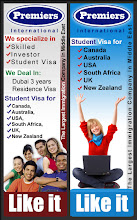USA Visitor Visa is a tourist visa to US. It is also known as B2 Visa. A visitor visa is a non-immigrant visa issued to people entering US temporarily for pleasure, tourism, or medical treatment. Any foreign citizen including parents who wants to visit USA for tourism, visiting children, family, friends, relatives, attending special events, family functions, ceremonies, or for medical treatment may qualify and can apply for Visitor Visa.
Note: Citizens of certain countries may not require visitor visa if the trip is less than 90 days. This is known US Visa Waiver Program (VWP).
Quick Facts about USA Visitor Visa
• Visitor visa or tourist visa is also known as B1-B2 or B2 visa for USA.
• Visitor visa is subject to approval. You must apply and get the visitor visa stamped in your passport.
• Visitor visa is granted for a specific purpose only, like tourism, medical treatment, etc. Person entering USA on visitor visa should not be involved in study, business, or work. If the purpose of your trip is business, you must apply for USA Business Visa (B1 Visa).
• Maximum length of stay in USA on visitor visa can be 6 months or less, which is subject to grant at the port of entry at US airport on arrival. An extension to maximum 6 months may be possible which is subject to approval. To request an extension, you will need to submit a USA visitor visa extension application to USCIS with fee.
How to get Visitor Visa for USA?
Getting a visitor visa to USA is subject to approval. Each applicant must have a valid passport, submit the application form, pay the fee, and appear for the visitor visa interview at the nearest applicable US consulate in their country.
Following is the visitor visa application and visitor visa stamping process for USA visitor visa from India.
Step 1.
Photograph for Visitor Visa
Step 2.
Visitor Visa Application
Step 3.
Visitor Visa Application Fee
Step 4.
Visitor Visa Interview Appointment
Step 5.
Visitor Visa Interview Process
Step 1. Get a digital photograph of each applicant
A digital photograph is required for while applying for a US visitor visa. The photograph must meet certain criteria. A good photographer or studio can get this picture if you mention photograph needed for US visitor visa purpose.
The digital photograph must meet the following requirements:
• The digital photograph must be a square.
• Minimum dimensions must be 600 pixels by 600 pixels.
• Maximum dimensions must be 1200 pixels by 1200 pixels.
• Image must be in color (24 bits per pixel).
• Image must be in the JPEG format (.jpg or .jpeg file extension).
• File size of the image must be less than or equal to 240 kilobytes.
See the complete photograph requirements for visitor visa.
Step 2. Complete visitor visa application form DS160
Visitor visa application (form DS160) must be completed online, over the internet. You can complete the application here.
After successfully completing the application, you will receive a confirmation with a 10-digit barcode. Take a printout of this page. This will be needed for setting up your visa interview appointment.
See complete details on how to fill US visitor visa application form DS160.
Step 3. Pay the visitor visa application fee
In India, the fee can be paid only at an authorized HDFC bank branch. Pay the visitor visa application fee and VFS service charges at any of the designated HDFC bank branches in India. You will need to submit a clear photocopy of the first page (bio-page) of your current passport to the bank when making your payment. The bank will issue you multiple copies of a visa fee receipt with a 10-digit barcode number. You will need the HDFC fee receipt barcode number to schedule your interview appointment. Please note, you are required to wait 24 hours from the date of purchase of your visa fee receipt before you can use it to schedule your interview appointment.
Read the complete details about visitor visa application fee.
Step 4. Take appointment for visa interview
Use VFS website to set up an appointment with the US embassy or consulate where you will be applying for your visitor visa. You can also walk in to a VFS service center to set up your appointment.
See complete details of taking a visitor visa interview appointment.
Step 5. Go for visa interview at designated US consulate
On the day and time of your appointment for interview, go to the consulate where your interview is scheduled. Carry all mandatory and supporting documents and originals.
Carry the following to your interview:
• Your passport (and your old passports if any)
• Your photograph
• The DS160 barcode page (you will not need the full application)
• The HDFC visa application fee receipts (if applying at a US consulate in India)
• VFS appointment letter
• Supporting documents.
See complete details of the visitor visa interview process.

















 Jason Kenney was born in Ontario and raised in Saskatchewan, where he graduated from Notre Dame College. He did undergraduate studies in philosophy at the University of San Francisco.
Jason Kenney was born in Ontario and raised in Saskatchewan, where he graduated from Notre Dame College. He did undergraduate studies in philosophy at the University of San Francisco.